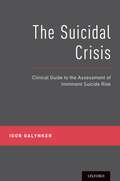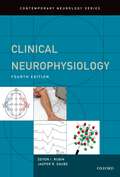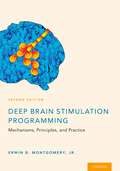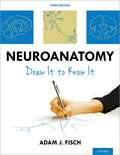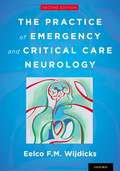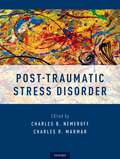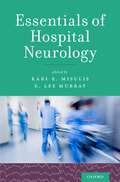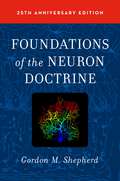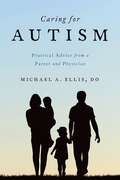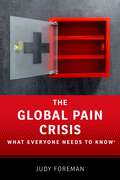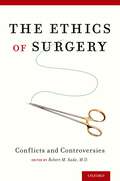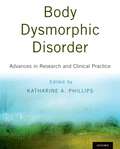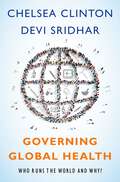- Table View
- List View
The Suicidal Crisis: Clinical Guide to the Assessment of Imminent Suicide Risk
by Dr Igor GalynkerMost people who die by suicide see a clinician prior to taking their lives. Therefore, one of the most difficult determinations clinicians must be able to make is whether any given patient is at risk for suicide in the immediate future. The Suicidal Crisis, Clinical Guide to the Assessment of Imminent Suicide Risk, is the first book written specifically to help clinicians evaluate the risk of such imminent suicidal behavior. The Suicidal Crisis is an essential work for every mental health professional and for anyone who would like to have a framework for understanding suicide. Written by master clinician Dr. Igor Galynker, the book presents methods for a systematic and comprehensive assessment of short-term suicide risk and for conducting risk assessment interviews in different settings. Dr. Galynker describes suicide as an attempt of a vulnerable individual to escape an unbearable life situation, which is perceived as both intolerable and inescapable. What sets the Suicidal Crisis apart from the other books of its kind is its sharp focus on those at the highest risk. It presents a wealth of clinical material within the easy-to-understand and intuitive framework of the Narrative-Crisis model of suicidal behavior. The book contains sixty individual case studies of actual suicidal individuals and their interviews, detailed instructions on how to conduct such interviews, and risk assessment test cases with answer keys. A unique feature of the book, not found in any other book on suicide, is a discussion of how clinicians' emotional responses to acutely suicidal individuals may help identify those at highest risk. In this timely, thorough, and well-written monograph, Dr. Galynker provides a method for understanding the suicidal process and of identifying those at the highest risk for taking their lives. Any clinician who works with suicidal individuals-and anybody who knows someone who has considered suicide-will find the book an essential and illuminating read.
The Suicidal Crisis: Clinical Guide to the Assessment of Imminent Suicide Risk
by Dr Igor GalynkerMost people who die by suicide see a clinician prior to taking their lives. Therefore, one of the most difficult determinations clinicians must be able to make is whether any given patient is at risk for suicide in the immediate future. The Suicidal Crisis, Clinical Guide to the Assessment of Imminent Suicide Risk, is the first book written specifically to help clinicians evaluate the risk of such imminent suicidal behavior. The Suicidal Crisis is an essential work for every mental health professional and for anyone who would like to have a framework for understanding suicide. Written by master clinician Dr. Igor Galynker, the book presents methods for a systematic and comprehensive assessment of short-term suicide risk and for conducting risk assessment interviews in different settings. Dr. Galynker describes suicide as an attempt of a vulnerable individual to escape an unbearable life situation, which is perceived as both intolerable and inescapable. What sets the Suicidal Crisis apart from the other books of its kind is its sharp focus on those at the highest risk. It presents a wealth of clinical material within the easy-to-understand and intuitive framework of the Narrative-Crisis model of suicidal behavior. The book contains sixty individual case studies of actual suicidal individuals and their interviews, detailed instructions on how to conduct such interviews, and risk assessment test cases with answer keys. A unique feature of the book, not found in any other book on suicide, is a discussion of how clinicians' emotional responses to acutely suicidal individuals may help identify those at highest risk. In this timely, thorough, and well-written monograph, Dr. Galynker provides a method for understanding the suicidal process and of identifying those at the highest risk for taking their lives. Any clinician who works with suicidal individuals-and anybody who knows someone who has considered suicide-will find the book an essential and illuminating read.
Clinical Neurophysiology (Contemporary Neurology Series)
by MD Devon Rubin MD Jasper DaubeClinical neurophysiologic testing is an important component of evaluating patients with complaints that may be attributed to diseases of the central or peripheral nervous system. This classic volume in the Contemporary Neurology Series covers the basic concepts underlying each of the testing techniques and provides comprehensive descriptions of the methods and wide range of electrophysiologic testing available for patients with epilepsy, neuromuscular diseases, movement disorders, demyelinating diseases, sleep disorders, autonomic disorders and those undergoing orthopedic and neurosurgical procedures. This text details the role of each study, the interpretation of findings, and their application clinical problems. This text describes the multiple diagnostic procedures for diverse diseases of the neuromuscular system, including: electroencephalography (EEG); electromyography and nerve conduction studies; single fiber EMG; polysomnography; surface EMG patterns, blood pressure, pulse, sweat measures; vestibular function testing; deep brain stimulator physiology; and intraoperative monitoring. It is a practical textbook for neurologists, physiatrists and clinical neurophysiologists in clinical or research practice or in training. Key Features of the New Edition Include: 1. Fully updated chapters to reflect new research and techniques in clinical neurophysiology. 2. Updated images illustrating key elements of techniques and basic concepts. 3. Case examples for practical application.
Clinical Neurophysiology (Contemporary Neurology Series)
by MD Devon Rubin MD Jasper DaubeClinical neurophysiologic testing is an important component of evaluating patients with complaints that may be attributed to diseases of the central or peripheral nervous system. This classic volume in the Contemporary Neurology Series covers the basic concepts underlying each of the testing techniques and provides comprehensive descriptions of the methods and wide range of electrophysiologic testing available for patients with epilepsy, neuromuscular diseases, movement disorders, demyelinating diseases, sleep disorders, autonomic disorders and those undergoing orthopedic and neurosurgical procedures. This text details the role of each study, the interpretation of findings, and their application clinical problems. This text describes the multiple diagnostic procedures for diverse diseases of the neuromuscular system, including: electroencephalography (EEG); electromyography and nerve conduction studies; single fiber EMG; polysomnography; surface EMG patterns, blood pressure, pulse, sweat measures; vestibular function testing; deep brain stimulator physiology; and intraoperative monitoring. It is a practical textbook for neurologists, physiatrists and clinical neurophysiologists in clinical or research practice or in training. Key Features of the New Edition Include: 1. Fully updated chapters to reflect new research and techniques in clinical neurophysiology. 2. Updated images illustrating key elements of techniques and basic concepts. 3. Case examples for practical application.
Deep Brain Stimulation Programming: Mechanisms, Principles and Practice
by Erwin B Montgomery, JrDeep brain stimulation programming (DBS) continues to grow as an effective therapy for a wide range of neurological and psychiatric disorders, helping patients reach optimal control of their disorder. With the technique finding so much success, the next question is how to make the complexities of post-operative programming cost-effective, especially when traditional medications and treatments can no longer do the job. The second edition of Deep Brain Stimulation Programming is fully revised and up-to-date with the latest technologies and focuses on post-operative programing, which no other text does. This book provides programmers with a foundation of the brain as an electrical device, focusing on the mechanisms by which neurons respond to electrical stimulation, how to control the stimulation and the regional anatomy, and the many variations that influence a patient's response to DBS. Dr. Montgomery explores new techniques of programming; including those based on stimulation frequency, closed-loop DBS, and the roles of oscillators in DBS; and new technological advances that make pre-existing theories of pathophysiology obsolete. Key Features of the Second Edition Include · Highlights post-operative deep brain stimulation; · Includes the most recent discoveries in deep brain stimulation programming; · Highly illustrated with figures for absorption of key programming and techniques; · Provides an appendix of additional resources available through the Greenville Neuromodulation Center.
Deep Brain Stimulation Programming: Mechanisms, Principles and Practice
by Erwin B Montgomery, JrDeep brain stimulation programming (DBS) continues to grow as an effective therapy for a wide range of neurological and psychiatric disorders, helping patients reach optimal control of their disorder. With the technique finding so much success, the next question is how to make the complexities of post-operative programming cost-effective, especially when traditional medications and treatments can no longer do the job. The second edition of Deep Brain Stimulation Programming is fully revised and up-to-date with the latest technologies and focuses on post-operative programing, which no other text does. This book provides programmers with a foundation of the brain as an electrical device, focusing on the mechanisms by which neurons respond to electrical stimulation, how to control the stimulation and the regional anatomy, and the many variations that influence a patient's response to DBS. Dr. Montgomery explores new techniques of programming; including those based on stimulation frequency, closed-loop DBS, and the roles of oscillators in DBS; and new technological advances that make pre-existing theories of pathophysiology obsolete. Key Features of the Second Edition Include · Highlights post-operative deep brain stimulation; · Includes the most recent discoveries in deep brain stimulation programming; · Highly illustrated with figures for absorption of key programming and techniques; · Provides an appendix of additional resources available through the Greenville Neuromodulation Center.
Neuroanatomy: Draw It to Know It
by Adam J. FischNeuroanatomy: Draw It to Know It, Third Edition teaches neuroanatomy in a purely kinesthetic way. In using this book, the reader draws each neuroanatomical pathway and structure, and in the process, creates memorable and reproducible schematics for the various learning points in Neuroanatomy in a hands-on, enjoyable and highly effective manner. In addition to this unique method, Neuroanatomy: Draw It to Know It also provides a remarkable repository of reference materials, including numerous anatomic and radiographic brain images and illustrations from many other classic texts to enhance the learning experience. In the third edition of this now-classic text, the author completely reorganized the book based on user-feedback, taking a more intuitive and easy-to-use approach. For the first time, the illustrations are in full color. No other text in neuroanatomy engages the reader in as direct a manner as this book and none covers the advanced level of detail found while retaining the simplistic approach to the learning which has become the cornerstone of the text. Neuroanatomy: Draw It to Know It is singular in its ability to engage and instruct without overwhelming any level of neuroanatomy student.
The Practice of Emergency and Critical Care Neurology
by Eelco F.M. WijdicksFully updated and revised, the second edition of The Practice of Emergency and Critical Care Neurology puts a more modern approach on the practice of emergency neurological care. When most texts within the field focus on the theoretical aspects, this book concentrates on the management of neurologic conditions, recognition of deterioration of neurologic functions, neurosurgical procedures, and immediate interventions. This text also presents hard data to explain why we do what we do. Dr. Wijdicks condenses essential information into several sections comprising of the principles in recognizing critically ill neurologic patients in the emergency department, the evaluation of symptoms indicating critical emergency, general principles of managing critically ill patients, monitoring devices and diagnostic tests, complete management of specific disorders in the neurosciences intensive care unit, postoperative neurosurgical and neurointerventional complications, management of medical complications, and end of life care. Key Features of the New Edition include 1. Additional chapters on critical consults in surgical and medical ICUs, critical care management, and comprehensive monitoring and biomarkers to reflect new research; 2. Rich illustrations using color photos of patients and drawings of important basic concepts of mechanism of acute neurologic disease; 3. Fully updated and comprehensive reference list; 4. A pocket book of selected tables and figures covering all essential points for quick reference and as a survival guide for house staff. This is the go-to guide for every physician, staff neurologist, neurointensivist, resident, and fellow in training with managing acutely ill neurologic patients.
The Practice of Emergency and Critical Care Neurology
by Eelco F.M. WijdicksFully updated and revised, the second edition of The Practice of Emergency and Critical Care Neurology puts a more modern approach on the practice of emergency neurological care. When most texts within the field focus on the theoretical aspects, this book concentrates on the management of neurologic conditions, recognition of deterioration of neurologic functions, neurosurgical procedures, and immediate interventions. This text also presents hard data to explain why we do what we do. Dr. Wijdicks condenses essential information into several sections comprising of the principles in recognizing critically ill neurologic patients in the emergency department, the evaluation of symptoms indicating critical emergency, general principles of managing critically ill patients, monitoring devices and diagnostic tests, complete management of specific disorders in the neurosciences intensive care unit, postoperative neurosurgical and neurointerventional complications, management of medical complications, and end of life care. Key Features of the New Edition include 1. Additional chapters on critical consults in surgical and medical ICUs, critical care management, and comprehensive monitoring and biomarkers to reflect new research; 2. Rich illustrations using color photos of patients and drawings of important basic concepts of mechanism of acute neurologic disease; 3. Fully updated and comprehensive reference list; 4. A pocket book of selected tables and figures covering all essential points for quick reference and as a survival guide for house staff. This is the go-to guide for every physician, staff neurologist, neurointensivist, resident, and fellow in training with managing acutely ill neurologic patients.
Post-Traumatic Stress Disorder
This volume brings together the leaders in the field of PTSD research to present an up-to-date summary and understanding of this complex disorder. All of our current knowledge and controversies concerning the diagnosis, epidemiology, course, pathophysiology and treatment are described in detail. The evidence for efficacy for each of the different forms of psychotherapy and pharmacotherapy is reviewed. Particular attention is paid to at-risk groups, including minorities, and coverage of PTSD throughout the world is reviewed as well. The authors present state-of-the-art findings in genetics, epigenetics, neurotransmitter function and brain imaging to provide the most current and comprehensive review of this burgeoning field.
Essentials of Hospital Neurology
by Karl E. Misulis and E. Lee MurrayEssentials of Hospital Neurology is a concise and practical guide to the diagnosis and management of neurologic disorders commonly encountered in hospital practice. This book discusses the business of hospital neurology, problem-oriented approaches to diagnosis, clinical details of important neurologic disorders that may be seen in the ER and inpatient settings, and key diagnostic and management strategies. This text focuses on practical management, making this an excellent source for the neurologist at any level from the resident to fellow to practicing physician. Medicine hospitalists and hospital-based mid-level providers will find this a useful resource for guiding care of their patients with neurologic conditions. Key Features of Essentials of Hospital Neurology · Incorporates up-to-date guidelines and best practices for neurologic hospital care; · Extensive use of bulleted lists, tables, and flowcharts; · Noted academic coauthors of selected sections for subspecialty expertise; · Provides key references and recommended readings; and · Includes critical reference material such as assessment scales, neurologic diagnostic tests, and guides to management of social and ethical issues.
Essentials of Hospital Neurology
Essentials of Hospital Neurology is a concise and practical guide to the diagnosis and management of neurologic disorders commonly encountered in hospital practice. This book discusses the business of hospital neurology, problem-oriented approaches to diagnosis, clinical details of important neurologic disorders that may be seen in the ER and inpatient settings, and key diagnostic and management strategies. This text focuses on practical management, making this an excellent source for the neurologist at any level from the resident to fellow to practicing physician. Medicine hospitalists and hospital-based mid-level providers will find this a useful resource for guiding care of their patients with neurologic conditions. Key Features of Essentials of Hospital Neurology · Incorporates up-to-date guidelines and best practices for neurologic hospital care; · Extensive use of bulleted lists, tables, and flowcharts; · Noted academic coauthors of selected sections for subspecialty expertise; · Provides key references and recommended readings; and · Includes critical reference material such as assessment scales, neurologic diagnostic tests, and guides to management of social and ethical issues.
Foundations of the Neuron Doctrine: 25th Anniversary Edition
by Gordon M ShepherdThe neuron doctrine, first formulated in 1891, states that the brain is constructed of individual neurons, organized into functioning circuits that mediate behavior. It is the fundamental principal that underlies all of neuroscience and clinical neurology. Foundations of the Neuron Doctrine gives an authoritative account of how this theory was the product of an explosion of histological studies and vigorous debates near the end of the nineteenth century by an extraordinary group of scientists, led by Santiago Ramon y Cajal of Spain, using a selective stain discovered by Camillo Golgi of Italy. They were the first to describe the distinctive branching patterns of nerve cells, providing evidence that the cells interact as individual units to form circuits, opposed however by Golgi, who held out for a view that the nerve cells form syncytial networks. Studies in the 1950s appeared to confirm the nerve cell as an individual unit, as embodied in the neuron doctrine, which became the basis for the rise of concepts of normal and disordered neural function since then. This 25th Anniversary Edition is timely. Recent studies are showing a much greater degree of complexity in neuronal organization, so that the debate of neuron versus network is again coming to the fore in neuroscience research. Unique to this Anniversary Edition is the inclusion of commentaries by distinguished international leaders - Marina Bentivoglio, Xavier De Felipe, Sten Grillner, Paolo Mazzarello, Larry Swanson, and Rafael Yuste - on the continuing relevance of the neuron doctrine for modern studies of the brain at all levels, from genes and molecules to microcircuits, neural networks, and behavior. As this new wave of modern studies expands our concepts of nervous function as the basis of behavior, Foundations of the Neuron Doctrine will be a unique source providing conceptual continuity from classical times to the present and into the future. With commentaries from Marina Bentivoglio Paolo Mazzarello Javier DeFelipe Larry Swanson Sten Grillner Rafael Yuste
Foundations of the Neuron Doctrine: 25th Anniversary Edition
by Gordon M ShepherdThe neuron doctrine, first formulated in 1891, states that the brain is constructed of individual neurons, organized into functioning circuits that mediate behavior. It is the fundamental principal that underlies all of neuroscience and clinical neurology. Foundations of the Neuron Doctrine gives an authoritative account of how this theory was the product of an explosion of histological studies and vigorous debates near the end of the nineteenth century by an extraordinary group of scientists, led by Santiago Ramon y Cajal of Spain, using a selective stain discovered by Camillo Golgi of Italy. They were the first to describe the distinctive branching patterns of nerve cells, providing evidence that the cells interact as individual units to form circuits, opposed however by Golgi, who held out for a view that the nerve cells form syncytial networks. Studies in the 1950s appeared to confirm the nerve cell as an individual unit, as embodied in the neuron doctrine, which became the basis for the rise of concepts of normal and disordered neural function since then. This 25th Anniversary Edition is timely. Recent studies are showing a much greater degree of complexity in neuronal organization, so that the debate of neuron versus network is again coming to the fore in neuroscience research. Unique to this Anniversary Edition is the inclusion of commentaries by distinguished international leaders - Marina Bentivoglio, Xavier De Felipe, Sten Grillner, Paolo Mazzarello, Larry Swanson, and Rafael Yuste - on the continuing relevance of the neuron doctrine for modern studies of the brain at all levels, from genes and molecules to microcircuits, neural networks, and behavior. As this new wave of modern studies expands our concepts of nervous function as the basis of behavior, Foundations of the Neuron Doctrine will be a unique source providing conceptual continuity from classical times to the present and into the future. With commentaries from Marina Bentivoglio Paolo Mazzarello Javier DeFelipe Larry Swanson Sten Grillner Rafael Yuste
Caring for Autism: Practical Advice from a Parent and Physician
by Michael A. EllisWhen a professional states, "Your child has Autism Spectrum Disorder (ASD)", it is enough to make your whole world fall apart. What does it mean to be on the autism spectrum? How will this affect your child's life, your life, the life of your family, and others you interact with? What sorts of medications, therapies, and alternative methods are used to help manage the disorder? What are the financial and legal ramifications? How will this affect schooling, your spiritual growth, and everyday life? These are just a few of the questions that will rapidly cross your mind. Caring for Autism: Practical Advice from a Parent and Physician delves into all these questions and more. As the father of a daughter with ASD and as a trained psychiatrist who specializes in ASD, Dr. Michael A. Ellis provides a holistic view of what comes after diagnosis. In user-friendly tones, he answers the most commonly asked questions about what it's actually like to live with ASD, what medications and therapies are available, and the global impact it has on the child's environment. With the help of his wife, Lori Layton Ellis, to provide a mother's perspective, Dr. Ellis shares personal stories of their 10-year journey in order to provide insight and support for anyone - patient, parent, caregiver - traversing the difficulties of autism.
Caring for Autism: Practical Advice from a Parent and Physician
by Michael A. EllisWhen a professional states, "Your child has Autism Spectrum Disorder (ASD)", it is enough to make your whole world fall apart. What does it mean to be on the autism spectrum? How will this affect your child's life, your life, the life of your family, and others you interact with? What sorts of medications, therapies, and alternative methods are used to help manage the disorder? What are the financial and legal ramifications? How will this affect schooling, your spiritual growth, and everyday life? These are just a few of the questions that will rapidly cross your mind. Caring for Autism: Practical Advice from a Parent and Physician delves into all these questions and more. As the father of a daughter with ASD and as a trained psychiatrist who specializes in ASD, Dr. Michael A. Ellis provides a holistic view of what comes after diagnosis. In user-friendly tones, he answers the most commonly asked questions about what it's actually like to live with ASD, what medications and therapies are available, and the global impact it has on the child's environment. With the help of his wife, Lori Layton Ellis, to provide a mother's perspective, Dr. Ellis shares personal stories of their 10-year journey in order to provide insight and support for anyone - patient, parent, caregiver - traversing the difficulties of autism.
GLOBAL PAIN CRISIS C: What Everyone Needs to Know® (What Everyone Needs To Know®)
by Judy ForemanTens of millions of people around the world live with chronic pain - many in such severe pain they are disabled by it. The Institute of Medicine estimates that chronic pain costs the U.S. alone $560 to $635 billion a year in direct medical costs and lost productivity. Morphine, an effective painkiller, costs only three cents a dose, yet because of excessive regulation in many countries, it is unavailable to millions of people who need it, even at the end of life. The World Health Organization notes that in addition to the one million end-stage AIDS/HIV patients who can't get morphine and other controlled medications, 5.5 million terminal cancer patients, nearly a million people suffering from accidents or violence, and an incalculable number of people living with chronic illnesses or recovering from surgery don't have access to it, either. Furthermore, women, children, older people, and the poor are disproportionally affected by inadequate pain relief. Physicians know almost nothing about chronic pain, much less how to treat it, for two reasons: medical schools barely teach it and government institutions allot almost nothing to the pain research budget. In The Global Pain Crisis: What Everyone Needs to Know®, renowned health journalist Judy Foreman addresses the most important questions about chronic pain: what is it, whom does it affect most, which pain relief methods in Western and alternative medicine are effective, what are the risks and benefits for opioids and marijuana, and how can the chronic pain crisis be resolved for good? Foreman's book is a wake-up call for a health problem that affects people across the globe, from all walks of life. Written in the classic, easy-to-read and quick reference style of the What Everyone Needs to Know® series, The Global Pain Crisis is a must-read for anyone whose life or work is affected by chronic pain.
The Global Pain Crisis: What Everyone Needs to Know® (What Everyone Needs To Know®)
by Judy ForemanTens of millions of people around the world live with chronic pain - many in such severe pain they are disabled by it. The Institute of Medicine estimates that chronic pain costs the U.S. alone $560 to $635 billion a year in direct medical costs and lost productivity. Morphine, an effective painkiller, costs only three cents a dose, yet because of excessive regulation in many countries, it is unavailable to millions of people who need it, even at the end of life. The World Health Organization notes that in addition to the one million end-stage AIDS/HIV patients who can't get morphine and other controlled medications, 5.5 million terminal cancer patients, nearly a million people suffering from accidents or violence, and an incalculable number of people living with chronic illnesses or recovering from surgery don't have access to it, either. Furthermore, women, children, older people, and the poor are disproportionally affected by inadequate pain relief. Physicians know almost nothing about chronic pain, much less how to treat it, for two reasons: medical schools barely teach it and government institutions allot almost nothing to the pain research budget. In The Global Pain Crisis: What Everyone Needs to Know®, renowned health journalist Judy Foreman addresses the most important questions about chronic pain: what is it, whom does it affect most, which pain relief methods in Western and alternative medicine are effective, what are the risks and benefits for opioids and marijuana, and how can the chronic pain crisis be resolved for good? Foreman's book is a wake-up call for a health problem that affects people across the globe, from all walks of life. Written in the classic, easy-to-read and quick reference style of the What Everyone Needs to Know® series, The Global Pain Crisis is a must-read for anyone whose life or work is affected by chronic pain.
Governing for Health: Advancing Health and Equity through Policy and Advocacy
by Fran BaumSome aspects of public health vary by locality or jurisdiction. Political challenges are not one of them. As governments on every scale become motivated by short-term economic gains, the essential causes of public health and equity are regularly subject to political questioning and financial shortcutting. Governing for Health is a counterpoint to this myopic approach -- a passionate, rigorous case for why the health of a society is both its greatest measure and its most untapped source of prosperity. Drawing on evidence from economic policy, urban planning, education, environmental policy, and civil action, Fran Baum offers more than a pie-in-sky vision of an equitable society. Governing for Health is an actionable (and inspiring) roadmap to a society that draws prosperity from advancing the health of its people. It utilizes methods of progress-measuring, city planning, and progressive policy foci to advance goals that are unreachable in traditional, economics-driven government practice. Whether for students in health equity, more seasoned public health professionals, or citizens interested in their community's and their own health this book offers a trenchant, richly rewarding and accessible look at the field's ultimate end game -- and with it, hope that it's closer than we think.
Governing for Health: Advancing Health and Equity through Policy and Advocacy
by Fran BaumSome aspects of public health vary by locality or jurisdiction. Political challenges are not one of them. As governments on every scale become motivated by short-term economic gains, the essential causes of public health and equity are regularly subject to political questioning and financial shortcutting. Governing for Health is a counterpoint to this myopic approach -- a passionate, rigorous case for why the health of a society is both its greatest measure and its most untapped source of prosperity. Drawing on evidence from economic policy, urban planning, education, environmental policy, and civil action, Fran Baum offers more than a pie-in-sky vision of an equitable society. Governing for Health is an actionable (and inspiring) roadmap to a society that draws prosperity from advancing the health of its people. It utilizes methods of progress-measuring, city planning, and progressive policy foci to advance goals that are unreachable in traditional, economics-driven government practice. Whether for students in health equity, more seasoned public health professionals, or citizens interested in their community's and their own health this book offers a trenchant, richly rewarding and accessible look at the field's ultimate end game -- and with it, hope that it's closer than we think.
ETHICS OF SURGERY C: Conflicts and Controversies
by Edited By Robert M. SadeAccording to popular belief, technical skill is far more important for surgeons than thoughtful deliberation. Nothing could be further from the truth. Although surgeons must sometimes make decisions rapidly on the basis of incomplete evidence and must respond to unexpected catastrophes in the operating room rapidly, those events are intermittent - most of the time surgeons deliberate on diagnostic problems and thoughtfully manage postoperative care, which is often intellectually challenging. The relationship of surgeons with their patients is, in a real sense, far more intimate and trusting than that of any other professional, a claim that is supported by the fact that patients surrender their bodies to their surgeons in a state of total helplessness and vulnerability when they undergo anesthesia. Because of that responsibility, no other professional group has a greater sense of dedication to the welfare of their patients than surgeons. Surgical culture is deeply steeped in ethics, and surgeons confront and resolve ethical dilemmas as much or more than most other professionals, although they often may not recognize the situations they resolve are problems in ethics - they are just part of the daily routine. This book is a compendium of articles from the recent surgical literature that address ethical issues chosen by surgeons because they are controversial and pertinent to the practice of surgery. The reader will not find a great deal of sophisticated dissection of fine philosophical distinctions in these discussions of ethical conflicts and controversies in surgery. Instead, they will discover differing viewpoints from thoughtful essayists, mostly surgeons, whose feet are firmly in contact with the ground and who have extensive experience in the real world of surgery, medicine, and law.
Body Dysmorphic Disorder: Advances in Research and Clinical Practice
by Katharine A. PhillipsThis landmark book is the first comprehensive edited volume on body dysmorphic disorder (BDD), a common and severe disorder. People with BDD are preoccupied with distressing or impairing preoccupations with non-existent or slight defects in their physical appearance. People with BDD think that they look ugly -- even monstrous -- although they look normal to others. BDD often derails sufferers' lives and can lead to suicide. BDD has been described around the world since the 1800s but was virtually unknown and unstudied until only several decades ago. Since then, research on BDD has dramatically increased understanding of this often-debilitating condition. Only recently, BDD was considered untreatable, but today, most sufferers can be successfully treated. This is the only book that provides comprehensive, in-depth, up-to-date information on BDD's clinical features, history, classification, epidemiology, morbidity, features in special populations, diagnosis and assessment, etiology and pathophysiology, treatment, and relationship to other disorders. Numerous chapters focus on cosmetic treatment, because it is frequently received but usually ineffective for BDD, which can lead to legal action and even violence toward treating clinicians. The book includes numerous clinical cases, which illustrate BDD's clinical features, its often-profound consequences, and recommended treatment approaches. This volume's contributors are the leading researchers and clinicians in this rapidly expanding field. Editor Katharine A. Phillips, head of the DSM-V committee on BDD, has done pioneering research on many aspects of this disorder, including its treatment. This book will be of interest to all clinicians who provide mental health treatment and to researchers in BDD, anxiety disorders, eating disorders, and other obsessive-compulsive and related disorders. It will be indispensable to surgeons, dermatologists, and other clinicians who provide cosmetic treatment. Students and trainees with an interest in psychology and mental health will also be interested in this book. This book fills a major gap in the literature by providing clinicians and researchers with cutting-edge, indispensable information on all aspects of BDD and its treatment.
Body Dysmorphic Disorder: Advances in Research and Clinical Practice
This landmark book is the first comprehensive edited volume on body dysmorphic disorder (BDD), a common and severe disorder. People with BDD are preoccupied with distressing or impairing preoccupations with non-existent or slight defects in their physical appearance. People with BDD think that they look ugly -- even monstrous -- although they look normal to others. BDD often derails sufferers' lives and can lead to suicide. BDD has been described around the world since the 1800s but was virtually unknown and unstudied until only several decades ago. Since then, research on BDD has dramatically increased understanding of this often-debilitating condition. Only recently, BDD was considered untreatable, but today, most sufferers can be successfully treated. This is the only book that provides comprehensive, in-depth, up-to-date information on BDD's clinical features, history, classification, epidemiology, morbidity, features in special populations, diagnosis and assessment, etiology and pathophysiology, treatment, and relationship to other disorders. Numerous chapters focus on cosmetic treatment, because it is frequently received but usually ineffective for BDD, which can lead to legal action and even violence toward treating clinicians. The book includes numerous clinical cases, which illustrate BDD's clinical features, its often-profound consequences, and recommended treatment approaches. This volume's contributors are the leading researchers and clinicians in this rapidly expanding field. Editor Katharine A. Phillips, head of the DSM-V committee on BDD, has done pioneering research on many aspects of this disorder, including its treatment. This book will be of interest to all clinicians who provide mental health treatment and to researchers in BDD, anxiety disorders, eating disorders, and other obsessive-compulsive and related disorders. It will be indispensable to surgeons, dermatologists, and other clinicians who provide cosmetic treatment. Students and trainees with an interest in psychology and mental health will also be interested in this book. This book fills a major gap in the literature by providing clinicians and researchers with cutting-edge, indispensable information on all aspects of BDD and its treatment.
Governing Global Health: Who Runs the World and Why?
by Chelsea Clinton Devi SridharThe past few decades have seen a massive increase in the number of international organizations focusing on global health. Campaigns to eradicate or stem the spread of AIDS, SARS, malaria, and Ebola attest to the increasing importance of globally-oriented health organizations. These organizations may be national, regional, international, or even non-state organizations-like Medicins Sans Frontieres. One of the more important recent trends in global health governance, though, has been the rise of public-private partnerships (PPPs) where private non-governmental organizations, for-profit enterprises, and various other social entrepreneurs work hand-in-hand with governments to combat specific maladies. A primary driver for this development is the widespread belief that by joining together, PPPs will attack health problems and fund shared efforts more effectively than other systems. As Chelsea Clinton and Devi Sridhar show in Governing Global Health, these partnerships are not only important for combating infectious diseases; they also provide models for developing solutions to a host of other serious global health challenges and questions beyond health. But what do we actually know about the accountability and effectiveness of PPPs in relation to the traditional multilaterals? According to Clinton and Sridhar, we have known very little because scholars have not accumulated enough data or developed effective ways to assess them-until now. In their analysis, they uncovered both strength and weaknesses of the model. Using principal-agent theory in which governments are the principals directing international agents of various type, they take a closer look at two major PPPs-the Global Fund to Fight HIV/AIDS, TB and Malaria and the GAVI Alliance-and two major more traditional international organizations-the World Health Organization and the World Bank. An even-handed and thorough empirical analysis of one of the most pressing topics in world affairs, Governing Global Health will reshape our understanding of how organizations can more effectively prevent the spread of communicable diseases like AIDS and reduce pervasive chronic health problems like malnutrition.
Governing Global Health: Who Runs the World and Why?
by Chelsea Clinton Devi SridharThe past few decades have seen a massive increase in the number of international organizations focusing on global health. Campaigns to eradicate or stem the spread of AIDS, SARS, malaria, and Ebola attest to the increasing importance of globally-oriented health organizations. These organizations may be national, regional, international, or even non-state organizations-like Medicins Sans Frontieres. One of the more important recent trends in global health governance, though, has been the rise of public-private partnerships (PPPs) where private non-governmental organizations, for-profit enterprises, and various other social entrepreneurs work hand-in-hand with governments to combat specific maladies. A primary driver for this development is the widespread belief that by joining together, PPPs will attack health problems and fund shared efforts more effectively than other systems. As Chelsea Clinton and Devi Sridhar show in Governing Global Health, these partnerships are not only important for combating infectious diseases; they also provide models for developing solutions to a host of other serious global health challenges and questions beyond health. But what do we actually know about the accountability and effectiveness of PPPs in relation to the traditional multilaterals? According to Clinton and Sridhar, we have known very little because scholars have not accumulated enough data or developed effective ways to assess them-until now. In their analysis, they uncovered both strength and weaknesses of the model. Using principal-agent theory in which governments are the principals directing international agents of various type, they take a closer look at two major PPPs-the Global Fund to Fight HIV/AIDS, TB and Malaria and the GAVI Alliance-and two major more traditional international organizations-the World Health Organization and the World Bank. An even-handed and thorough empirical analysis of one of the most pressing topics in world affairs, Governing Global Health will reshape our understanding of how organizations can more effectively prevent the spread of communicable diseases like AIDS and reduce pervasive chronic health problems like malnutrition.
